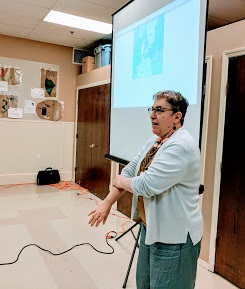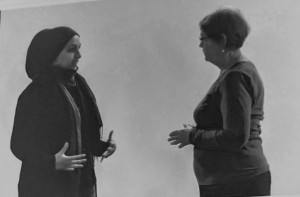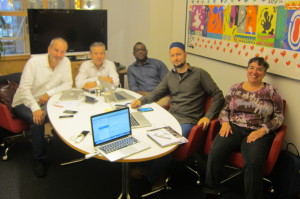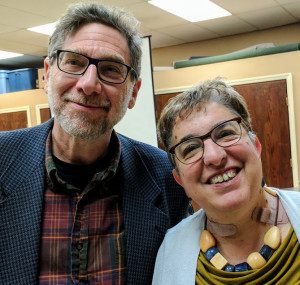Editor’s note: This post was written jointly by Ann Lippel and Sarita Eisenberg.
 Shomrei was fortunate to host Rabbi Rebecca Lillian, Rabbi of the Egalitarian Synagogue of Malmo, Sweden, this past Sunday (Dec 4). Rabbi Lillian was in New Jersey to attend the Third Annual Muslim & Jewish Women Leadership Conference, sponsored by the Sisterhood of Salaam-Shalom.
Shomrei was fortunate to host Rabbi Rebecca Lillian, Rabbi of the Egalitarian Synagogue of Malmo, Sweden, this past Sunday (Dec 4). Rabbi Lillian was in New Jersey to attend the Third Annual Muslim & Jewish Women Leadership Conference, sponsored by the Sisterhood of Salaam-Shalom.
Rabbi Lillian is an activist dedicated to building bridges between communities. She introduced us to her work in the Malmo Jewish community and her interfaith work, specifically with regard to Jewish-Muslim cooperation.
Sweden opened its doors to refugees after World War 2. Although officially neutral, Sweden assisted Germany by providing food for its troops. After the war, Sweden became determined to make amends for doing nothing to stop Germany during the war. Since then, there have been two waves of Jewish immigrants: one immediately after the war in 1945 and another in the 1960’s as a result of a government purge of Jews from Poland. These religiously oriented refugees combined with a small group of assimilated Jews who had emigrated to Sweden at the turn of the century. Today, there are around 2,000 to 3,000 Jews in Malmo (about 10% of the total Jews in Sweden).
The impetus for rapid economic and demographic changes in Malmo was the 1995 construction of the ten mile Oresund bridge between Copenhagen and Malmo. The physical bridge has opened the way for refugees from non-European countries to settle in Sweden. Malmo, being the primary transfer point from Europe into Sweden, has thus seen a dramatic rise in Muslim population since 2002. Many of the Muslim refugees are resettled elsewhere, but there are over 10,000 Muslims who have settled in Malmo. In Sweden (a highly secular society which prides itself on solving civic issues without support of religious institutions), assimilation of Islamic émigrés has become a cultural challenge.
 Lessons from the past demonstrate that many Jewish émigrés from war-torn Europe faced similar challenges when acculturating to America. So, who in Sweden would better relate to the current dislocation of Malmo refugees than its Jewish citizens? Rabbi Lillian herself is the daughter and daughter-in-law of refugees. (Her mother-in-law was among the 8,000 Jews rescued from Denmark during the war.)
Lessons from the past demonstrate that many Jewish émigrés from war-torn Europe faced similar challenges when acculturating to America. So, who in Sweden would better relate to the current dislocation of Malmo refugees than its Jewish citizens? Rabbi Lillian herself is the daughter and daughter-in-law of refugees. (Her mother-in-law was among the 8,000 Jews rescued from Denmark during the war.)
 All Swedish émigrés have to learn the Swedish language before they can fully enter the economic system. A system of informal cafes where refugees and Swedes interact has developed to encourage this language learning. Rabbi Lillian, enlisting the cooperation of Muslim Imams and Lutheran clergy, has taken the café concept to a new plateau and used it to forge a bridge between peoples. Rabbi Lillian’s pictures of Jews and Muslims swapping childcare tips, eating together at the cafes, and sharing Shabbath or Pesach meals in the homes of Malmo Jews are uplifting.
All Swedish émigrés have to learn the Swedish language before they can fully enter the economic system. A system of informal cafes where refugees and Swedes interact has developed to encourage this language learning. Rabbi Lillian, enlisting the cooperation of Muslim Imams and Lutheran clergy, has taken the café concept to a new plateau and used it to forge a bridge between peoples. Rabbi Lillian’s pictures of Jews and Muslims swapping childcare tips, eating together at the cafes, and sharing Shabbath or Pesach meals in the homes of Malmo Jews are uplifting.
 What is courage in the face of cultural misunderstanding? Rabbi Lillian has shown that small acts of heroism like sitting down at a table together or breaking bread together build bridges to future co-existence.
What is courage in the face of cultural misunderstanding? Rabbi Lillian has shown that small acts of heroism like sitting down at a table together or breaking bread together build bridges to future co-existence.
- Impressions from the Shomrei Civil Rights Trip - Thu, Jan 11, 2024
- Quiet Heroism in Interfaith Cooperation - Thu, Dec 8, 2016
- Translation – A Path to Tolerance - Thu, Mar 31, 2016
- Shabbat in Uzbekistan - Wed, Apr 17, 2024
- Purim in Uzbekistan - Thu, Apr 4, 2024
- Quick-ish Soups - Thu, Feb 22, 2024
